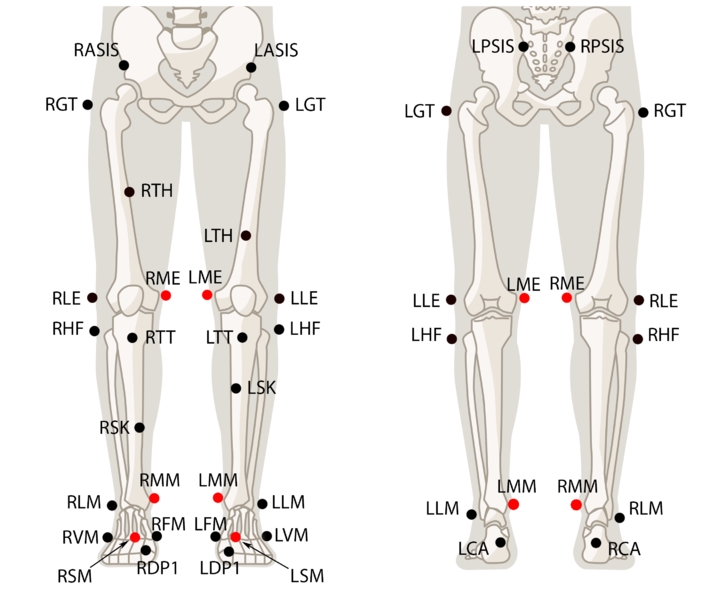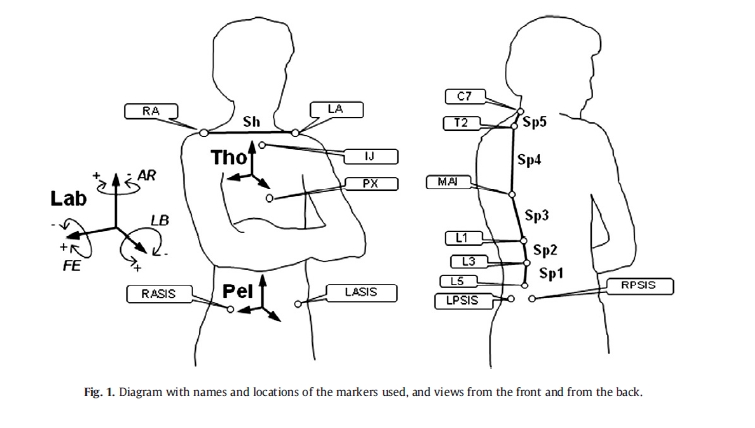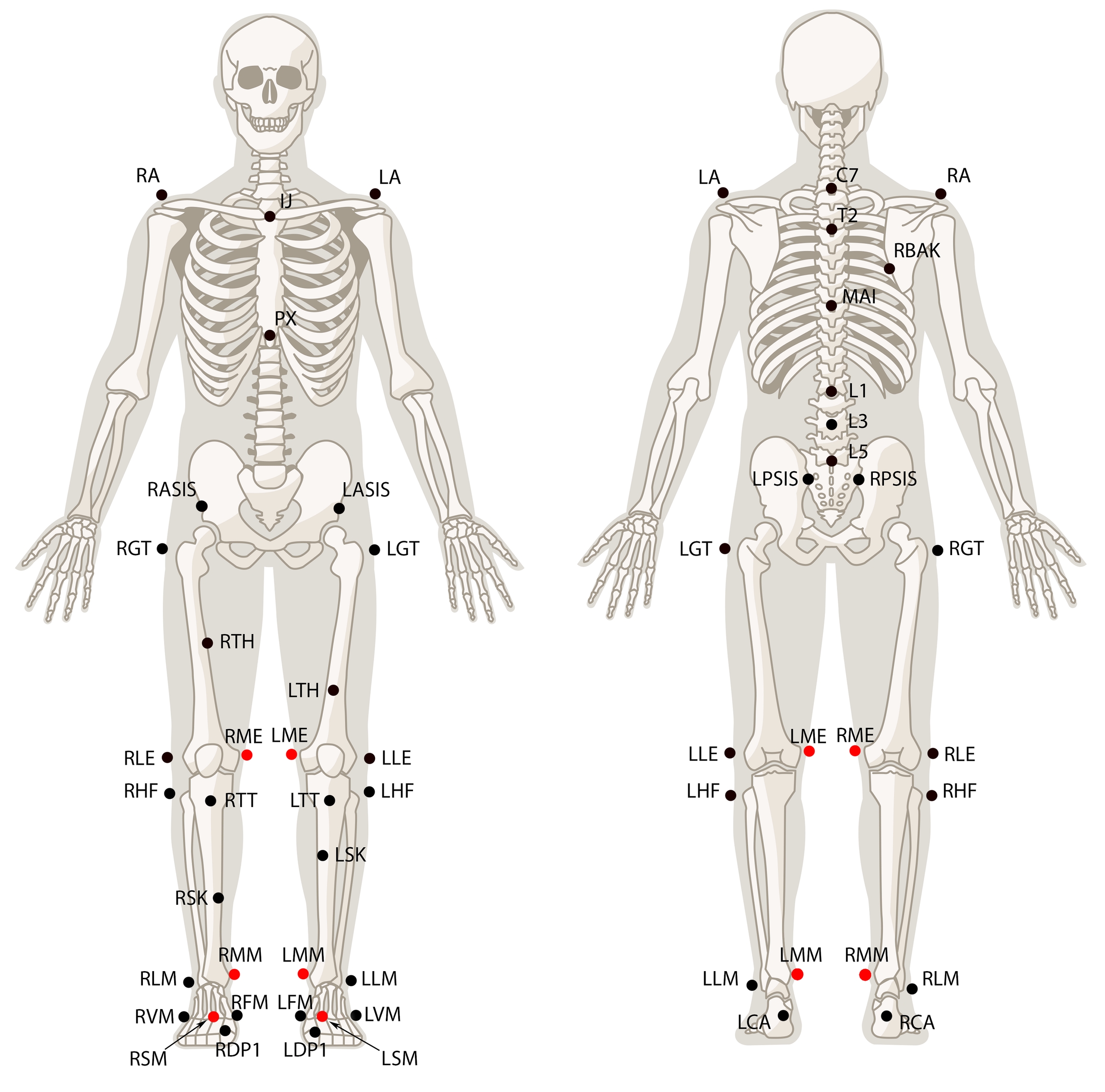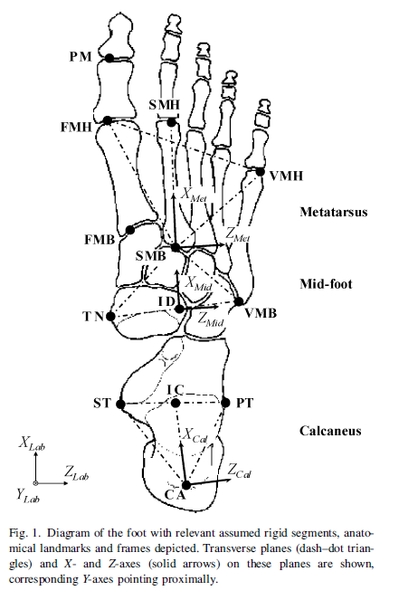Rizzoli Marker Sets
Overview
Rizzoli Marker Sets protocols are available in Motive for human motion tracking. The Rizzoli protocols are developed and researched from the Movement Analysis Laboratory in the Rizzoli Orthopedics Institute, Italy.
In biomechanics tracking applications, proper marker placements are critical to the human motion tracking and the respective biomechanical analysis; and for this reason, precise identification of the anatomical landmarks and marker placements have to be performed[1]. With a Motive Body license, marker locations are indicated over the avatar displayed in the Builder pane. This page provides additional details on the anatomical locations of the marker placements for the Rizzoli protocols.
Rizzoli Lower Body
The Rizzoli Lower Body template integrates a novel marker placement for lower body tracking. This Marker Sets is designed to provide a complete description of 3D segment and joint motion for analyzing the pelvis and lower extremity kinematics[1]. The following chart includes anatomical landmark descriptions of where the markers need to be placed for accurate and reliable analysis of the lower body movement.
Includes total six calibration markers for creating the Skeleton asset during static trials (RME/LME, RMM/LMM, RSM/LSM). They are highlighted in red.
Two thigh markers (RTH and LTH) and two shank markers (RSK and LSK) have been added to the protocol to better distinguish the left and right of the Skeleton.
For more information on the segment and joint definitions, please refer to the referenced research papers.


Rizzoli Lower Body Protocol Markers
RTH LTH
Upper Leg
Place near the midline of the thigh. Used only for a tracking purpose of distinguishing left and right side. For best result, offset the height of the marker between left and right side.
Upper Leg
Most lateral prominence of the lateral femoral epicondyle. Together with LM markers, it determines the location of knee joint axis.
RSK LSK
Upper Leg
Place near the midline of the shin. Used only for a tracking purpose of distinguishing left and right side. For best result, offset the height of the marker between left and right side.
Foot
Upper ridge of the calcaneus posterior surface. The aspect of the Achilles tendon insertion on the calcaneus[1].
RDP1 LDP1
Foot
These markers are added on the distal phalanx only for the toe segment tracking purpose, and they are not included in the biomechanical analysis. Place the marker near the end of the big toe. More specifically, the marker should be placed at the distal end of the first phalanges.
*These markers need to be removed after the Skeleton has been created in Motive.
Rizzoli Upper
This Marker Set is designed for tracking multi-segment trunk kinematics[2]. Total 10 markers are place on the torso and 4 markers are placed around pelvis[2], and an extra back marker (RBAK) was added on the right scapula solely for improved tracking.
Total four markers are used for tracking the thorax segment, where two acromion markers (RA and LA) make the shoulder line segment for tracking the segment rotation and translations[2].
For the spine motion tracking, a 5-link segment model is created from the six spine markers[2].
An extra RBAK marker was added to the protocol for improved identification of left and right side of the tracked Skeleton.
For more information on the Rizzoli Trunk Marker Set, please refer to the referenced research papers.


Rizzoli Trunk Markers
RBAK
Torso
Placed near the right scapula apex: Used only to Identify left and right of the Skeleton.
Rizzoli Body
The Rizzoli Body template combines the Rizzoli Lower Body Protocol and the Rizzoli Trunk Protocol to provide tracking of the full-body kinematics.

Rizzoli Full Body Markers
RBAK
Torso
Placed near the right scapula apex: Used only for identifying left and right of the Skeleton.
RTH LTH
Upper Leg
Place near the midline of the thigh. Used only for a tracking purpose of distinguishing left and right side. For best result, offset the height of the marker between left and right side.
Upper Leg
Most lateral prominence of the lateral femoral epicondyle. Together with LM markers, it determines the location of knee joint axis.
RSK LSK
Upper Leg
Place near the midline of the shin. Used only for a tracking purpose of distinguishing left and right side For best result, offset the height of the marker between left and right side.
Foot
Upper ridge of the calcaneus posterior surface. The aspect of the Achilles tendon insertion on the calcaneus[1].
Foot
These markers are added on the distal phalanx only for the toe segment tracking purpose, and they are not included in the biomechanical analysis. Place the marker near the end of the big toe. More specifically, the marker should be placed at the distal end of the first phalanges.
*These markers need to be removed after the Skeleton has been created in Motive.
Rizzoli Foot
The Rizzoli Left/Right Foot template provides precise tracking of the foot kinematics by modeling three-foot segments – rear-foot, mid-foot, and fore-foot – from the markers that are placed on carefully identified anatomical landmarks of the foot [3]. The following diagrams and the chart detail on where each marker needs to be placed on the right foot protocol. The placements for the left foot will be anatomically equivalent but reflected.
There are two calibration markers in each foot protocol. They are located at the apex of the medial malleolus (RMM/LMM) and the lowest point of the heel center (RCAp/LCAp). These markers are only for creating the asset for static trials, and they need to be removed for dynamic trials.
Refer to the referenced papers for specific information on the joint and segment definitions.


Rizzoli Foot Markers
*These markers need to be removed after the Skeleton has been created in Motive.
References
Leardini, A., Sawacha, Z., Paolini, G., Ingrosso, S., Nativo, R., Benedetti, M.G., 2007. A new anatomically based protocol for gait analysis in children. Gait Posture 26. 560-571.
Leardini, A., Biagi, F., Merlo, A., Belvedere, C., Benedetti, M.G., 2011. Multi-segment trunk kinematics during locomotion and elementary exercises. Clin. Biomech. 26, 562-571.
Leardini, A., Benedetti, M.G., Berti, L., Bettinelli, D., Nativo, R., Giannini, S., 2007. Rear-foot, mid-foot and fore-foot motion during the stance phase of gait. Gait Posture 25. 453-462.
Portinaro, N., Leardini, A., Panou, A., Monzani, V., Caravaggi, P., 2014. Modifying the Rizzoli foot model to improve the diagnosis of pes-planus: application to kinematics of feet in teenagers. Journal of Foot and Ankle Research 7, 57.
Was this helpful?

